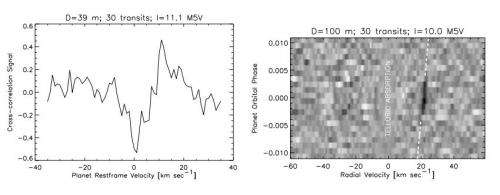February 20, 2013 report
Astronomers suggest new telescopes could detect biomarker gasses in exoplanet atmospheres

(Phys.org)—Astronomers in the Netherlands write in a paper published in The Astrophysical Journal, that construction of new ground based telescopes could allow for discerning if small exoplanets have biomarker gasses in their atmospheres, and by extension some form of life existing on them. They propose that using newly developed techniques to separate out possible atmospheric gasses from exoplanets, from the oxygen in our own atmosphere using data from the planned European Extremely Large Telescope (E-ELT), or by building large arrays of cheaper to develop flux collector telescopes, could allow for the detection of such biomarkers from land based telescopes.
Astronomers have long maintained that if a distant planet had an atmosphere with some amount of oxygen in it, the likelihood of life existing on that planet would be very high, as oxygen in our own atmosphere exists only because of plants producing it through photosynthesis. Detecting it, however, presents a significant challenge, particularly for ground based telescopes that must peer though the distorting effects of our own atmosphere. For that reason, most astronomers have assumed we would have to wait for space based telescopes to be built and sent aloft. Unfortunately, plans for such telescopes have been scuttled, leaving little hope for those wishing to use such a method to search for extraterrestrial life. Now, researches in the Netherlands say there may be another way.
They say that it's possible to detect biomarker gasses by carefully measuring the wavelengths of absorption lines in the light coming from an exoplanet, by taking into account the Doppler effect that comes about as the speed of the exoplanet moves relative to us here on Earth. They note that an exoplanet with oxygen in its atmosphere as seen against a red dwarf star would have a signal only three times weaker than a signal that has already been found using the technique that indicates carbon monoxide in the atmosphere of the hot Jupiter planet Tau Bootis.
That means, they say, that a new telescope, such as the E-ELT (to be built by the European Southern Observatory with a planned completion data of 2022) could be used to find small rocky exoplanets with oxygen or other biomarkers in their atmospheres. They also suggest that building an array of far cheaper flux collector telescopes could do the trick as well.
More information: Finding extraterrestrial life using ground-based high-dispersion spectroscopy, I. A. G. Snellen et al. 2013 ApJ 764 182 doi:10.1088/0004-637X/764/2/182 . Arxiv: arxiv.org/abs/1302.3251
Abstract
Exoplanet observations promise one day to unveil the presence of extraterrestrial life. Atmospheric compounds in strong chemical disequilibrium would point to large-scale biological activity just as oxygen and methane do in the Earth's atmosphere. The cancellation of both the Terrestrial Planet Finder and Darwin missions means that it is unlikely that a dedicated space telescope to search for biomarker gases in exoplanet atmospheres will be launched within the next 25 years. Here we show that ground-based telescopes provide a strong alternative for finding biomarkers in exoplanet atmospheres through transit observations. Recent results on hot Jupiters show the enormous potential of high-dispersion spectroscopy to separate the extraterrestrial and telluric signals, making use of the Doppler shift of the planet. The transmission signal of oxygen from an Earth-twin orbiting a small red dwarf star is only a factor of three smaller than that of carbon monoxide recently detected in the hot Jupiter τ Boötis b, albeit such a star will be orders of magnitude fainter. We show that if Earth-like planets are common, the planned extremely large telescopes can detect oxygen within a few dozen transits. Ultimately, large arrays of dedicated flux-collector telescopes equipped with high-dispersion spectrographs can provide the large collecting area needed to perform a statistical study of life-bearing planets in the solar neighborhood.
Journal information: Astrophysical Journal
© 2013 Phys.org





















